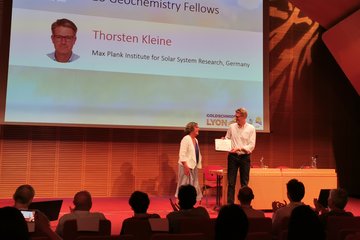Alle Typen
1.
Zeitschriftenartikel
Applying machine learning to a nonlinear spectral mixing model for mapping lunar soils composition using CHANDRAYAAN-1 M3 data. Planetary and Space Science 244, S. 105870 (2024)
2.
Zeitschriftenartikel
Applying machine learning to a nonlinear spectral mixing model for mapping lunar soils composition using CHANDRAYAAN-1 M3 data. Planetary and Space Science 244, S. 105870 (2024)
3.
Zeitschriftenartikel
Applying machine learning to a nonlinear spectral mixing model for mapping lunar soils composition using CHANDRAYAAN-1 M3 data. Planetary and Space Science 244, S. 105870 (2024)
4.
Zeitschriftenartikel
Comment on "Long-term Variations of Venus's 365 nm Albedo Observed by Venus Express, Akatsuki, MESSENGER, and the Hubble SpaceTelescope" by Lee et al. (2019, AJ, 158, 126). Research notes of the AAS 3 (11), 168 (2020)
5.
Zeitschriftenartikel
Venus crater-related radar-dark parabolas and neighboring terrains: A comparison of 1-μm emissivity and microwave properties. Icarus 330, S. 103 - 122 (2019)
6.
Zeitschriftenartikel
Aerosol properties in the upper clouds of Venus from glory observations by the Venus Monitoring Camera (Venus Express mission). Icarus 299, S. 272 - 293 (2018)
7.
Zeitschriftenartikel
UV contrasts and microphysical properties of the upper clouds of Venus from the UV and NIR VMC/VEx images. Icarus 260, S. 190 - 204 (2015)
8.
Zeitschriftenartikel
The VMC/VEx photometry at small phase angles: Glory and the physical properties of particles in the upper cloud layer of Venus. Planetary and Space Science 113, S. 120 - 134 (2015)
9.
Zeitschriftenartikel
Optical properties of the Venus upper clouds from the data obtained by Venus Monitoring Camera on-board the Venus Express. Planetary and Space Science 113, S. 135 - 158 (2015)
10.
Zeitschriftenartikel
Glory on Venus cloud tops and the unknown UV absorber. Icarus 234, S. 200 - 203 (2014)
11.
Vortrag
The latitude gradient of droplet sizes of the upper Venus clouds at 35-60S from the VMC/VEx observations. 40th COSPAR Scientific Assembly, Moscow, Russia (2014)











